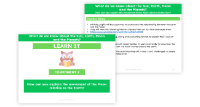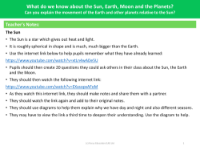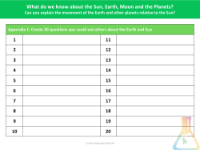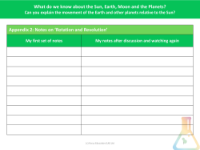How can you explain the movement of the Earth and other planets relative to the sun? - Presentation

Science Resource Description
The educational programme for Year 5 Science students delves into the fascinating movements of the Earth, Moon, and other planets within our solar system. Pupils are expected to describe how the Earth and other planets orbit the Sun, as well as the Moon's orbit around the Earth. They also explore the spherical nature of these celestial bodies and understand how the Earth's rotation is responsible for the cycle of day and night, including the apparent movement of the Sun across the sky. The curriculum aims to provide substantive knowledge, ensuring that students can explain these planetary and lunar movements with confidence, and demonstrate their understanding of how night and day occur.
Students are encouraged to engage in research, looking into the characteristics of the planets in our solar system, including their orbital periods. This study extends to understanding the dimensions of the Sun, Earth, and Moon, and using vocabulary such as 'solar system', 'planet', 'spherical', 'crescent moon', 'gibbous moon', and 'eclipse'. The programme is designed to build upon prior knowledge, such as the concepts of light and dark covered in Year 3, while incorporating new insights into the physical science of our solar system. Through various learning stages – linking prior knowledge, learning new information, checking understanding, showing comprehension, and reinforcing memory – students are equipped to articulate their knowledge about the Sun, Earth, Moon, and other planets with clarity and depth.




